2012 Peugeot 3008 Hybrid 4 parking brake
[x] Cancel search: parking brakePage 151 of 284
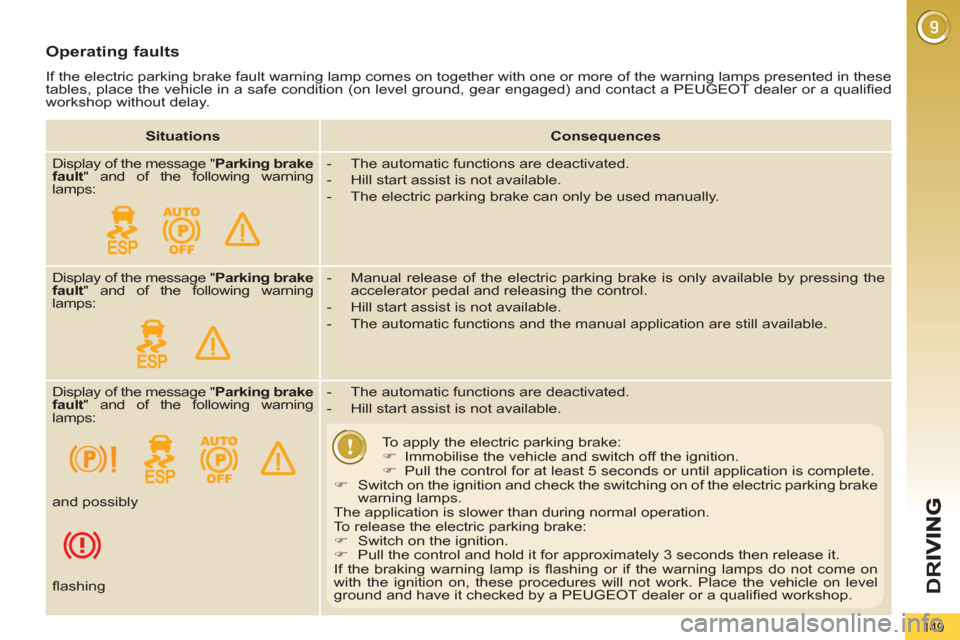
D
R
149
Operating faults
If the electric parking brake fault warning lamp comes on together with one or more of the warning lamps presented in these
tables, place the vehicle in a safe condition (on level ground, gear engaged) and contact a PEUGEOT dealer or a qualifi ed
workshop without delay.
Situations
Consequences
Display of the message " Parking brake
fault
" and of the following warning
lamps:
- The automatic functions are deactivated.
- Hill start assist is not available.
- The electric parking brake can only be used manually.
Display of the message " Parking brake
fault
" and of the following warning
lamps:
- Manual release of the electric parking brake is only available by pressing the
accelerator pedal and releasing the control.
- Hill start assist is not available.
- The automatic functions and the manual application are still available.
Display of the message " Parking brake
fault
" and of the following warning
lamps:
- The automatic functions are deactivated.
- Hill start assist is not available.
To apply the electric parking brake:
�)
Immobilise the vehicle and switch off the ignition.
�)
Pull the control for at least 5 seconds or until application is complete.
�)
Switch on the ignition and check the switching on of the electric parking brake
warning lamps.
The application is slower than during normal operation.
To release the electric parking brake:
�)
Switch on the ignition.
�)
Pull the control and hold it for approximately 3 seconds then release it.
If the braking warning lamp is fl ashing or if the warning lamps do not come on
with the ignition on, these procedures will not work. Place the vehicle on level
ground and have it checked by a PEUGEOT dealer or a qualifi ed workshop. and possibly
fl ashing
Page 152 of 284
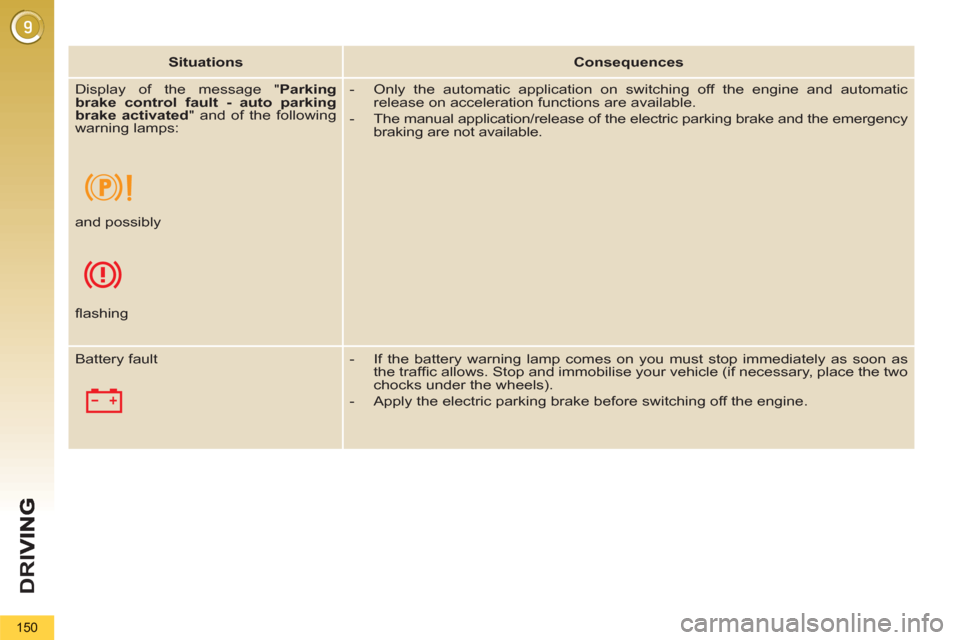
D
R
I
150
Situations
Consequences
Display of the message " Parking
brake control fault - auto parking
brake activated
" and of the following
warning lamps:
- Only the automatic application on switching off the engine and automatic
release on acceleration functions are available.
- The manual application/release of the electric parking brake and the emergency
braking are not available.
and possibly
fl ashing
Battery fault
- If the battery warning lamp comes on you must stop immediately as soon as
the traffi c allows. Stop and immobilise your vehicle (if necessary, place the two
chocks under the wheels).
- Apply the electric parking brake before switching off the engine.
Page 160 of 284
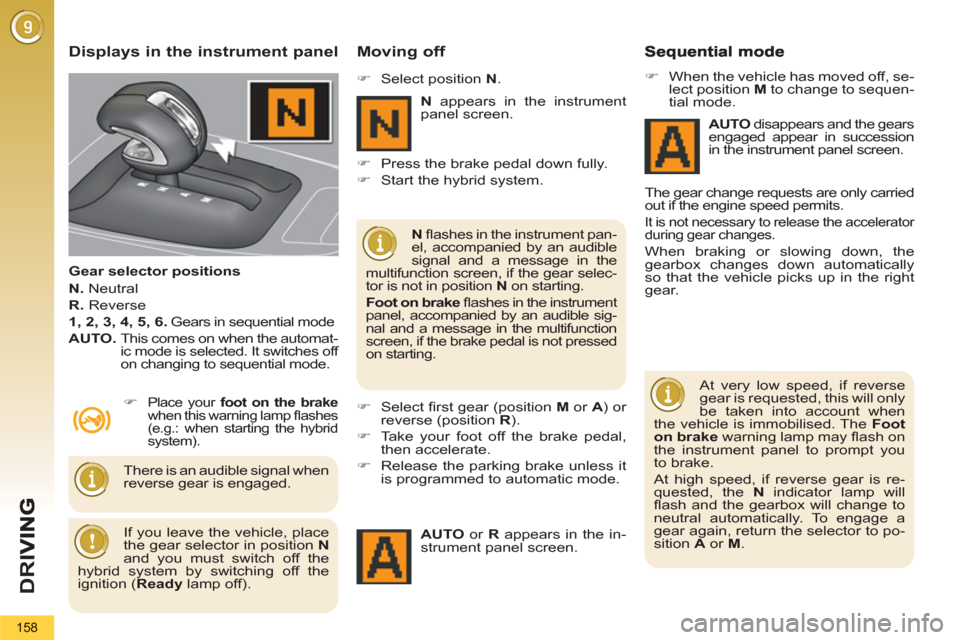
D
R
I
158
Displays in the instrument panel
Gear selector positions
N.
Neutral
R.
Reverse
1, 2, 3, 4, 5, 6.
Gears in sequential mode
AUTO.
This comes on when the automat-
ic mode is selected. It switches off
on changing to sequential mode.
Moving off
�)
Place your foot on the brake
when this warning lamp fl ashes
(e.g.: when starting the hybrid
system).
�)
Select position N
.
�)
Select fi rst gear (position M
or A
) or
reverse (position R
).
�)
Take your foot off the brake pedal,
then accelerate.
�)
Release the parking brake unless it
is programmed to automatic mode.
AUTO
or R
appears in the in-
strument panel screen.
N
fl ashes in the instrument pan-
el, accompanied by an audible
signal and a message in the
multifunction screen, if the gear selec-
tor is not in position N
on starting.
Foot on brake
fl ashes in the instrument
panel, accompanied by an audible sig-
nal and a message in the multifunction
screen, if the brake pedal is not pressed
on starting.
There is an audible signal when
reverse gear is engaged. N
appears in the instrument
panel screen.
�)
When the vehicle has moved off, se-
lect position M
to change to sequen-
tial mode.
AUTO
disappears and the gears
engaged appear in succession
in the instrument panel screen.
The gear change requests are only carried
out if the engine speed permits.
It is not necessary to release the accelerator
during gear changes.
When braking or slowing down, the
gearbox changes down automatically
so that the vehicle picks up in the right
gear.
At very low speed, if reverse
gear is requested, this will only
be taken into account when
the vehicle is immobilised. The Foot
on brake
warning lamp may fl ash on
the instrument panel to prompt you
to brake.
At high speed, if reverse gear is re-
quested, the N
indicator lamp will
fl ash and the gearbox will change to
neutral automatically. To engage a
gear again, return the selector to po-
sition A
or M
.
If you leave the vehicle, place
the gear selector in position N
and you must switch off the
hybrid system by switching off the
ignition ( Ready
lamp off).
�)
Press the brake pedal down fully.
�)
Start the hybrid system.
Page 162 of 284
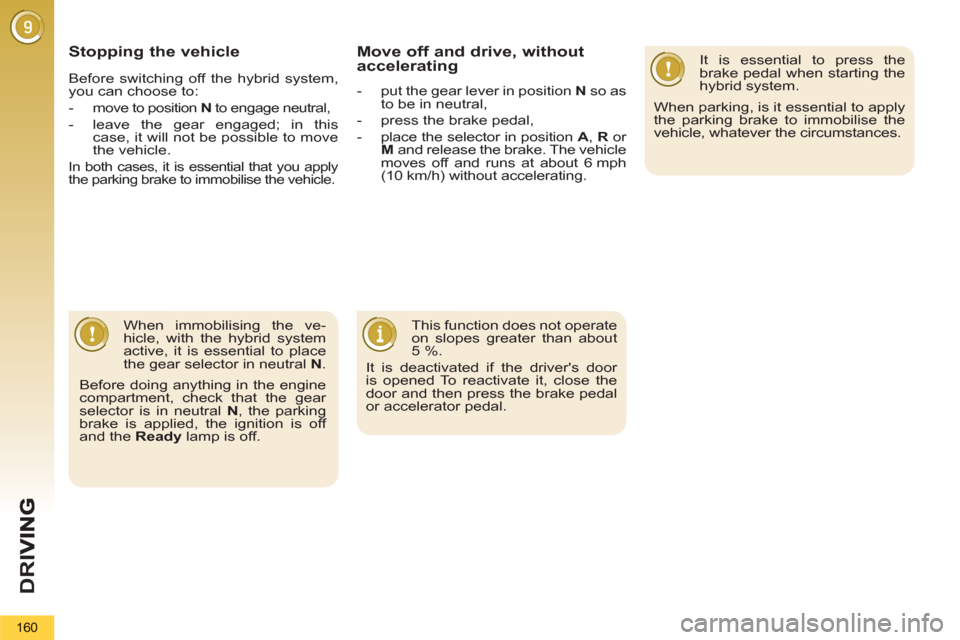
D
R
I
160
Stopping the vehicle
It is essential to press the
brake pedal when starting the
hybrid system.
When parking, is it essential to apply
the parking brake to immobilise the
vehicle, whatever the circumstances.
When immobilising the ve-
hicle, with the hybrid system
active, it is essential to place
the gear selector in neutral N
.
Before doing anything in the engine
compartment, check that the gear
selector is in neutral N
, the parking
brake is applied, the ignition is off
and the Ready
lamp is off.
Before switching off the hybrid system,
you can choose to:
- move to position N
to engage neutral,
- leave the gear engaged; in this
case, it will not be possible to move
the vehicle.
In both cases, it is essential that you apply
the parking brake to immobilise the vehicle.
Move off and drive, withoutaccelerating
- put the gear lever in position N
so as
to be in neutral,
- press the brake pedal,
- place the selector in position A
, R
or
M
and release the brake. The vehicle
moves off and runs at about 6 mph
(10 km/h) without accelerating.
This function does not operate
on slopes greater than about
5 %.
It is deactivated if the driver's door
is opened To reactivate it, close the
door and then press the brake pedal
or accelerator pedal.
Page 171 of 284
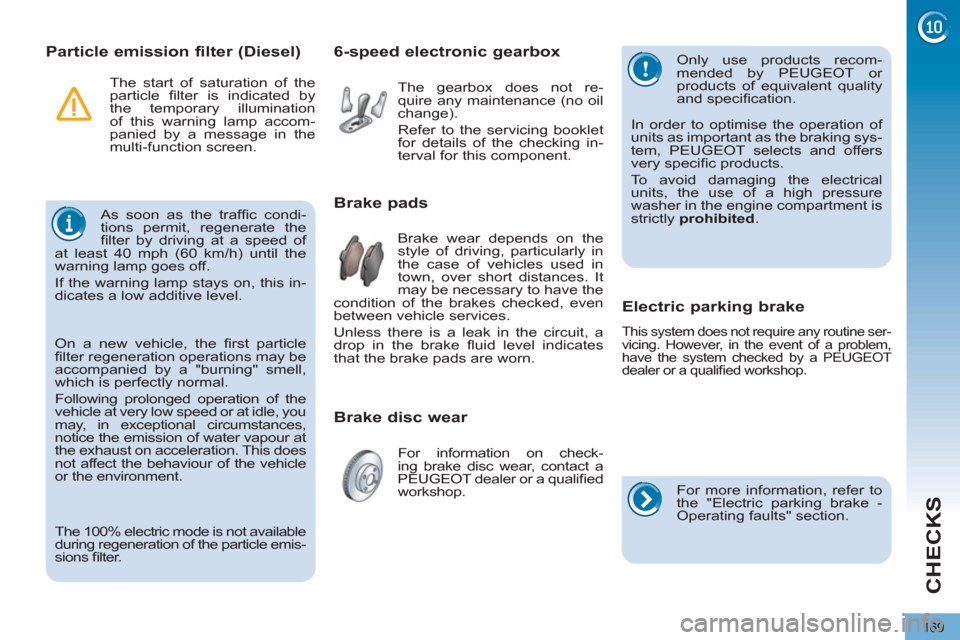
CHECKS
169
Particle emission filter (Diesel)
As soon as the traffi c condi-
tions permit, regenerate the
fi lter by driving at a speed of
at least 40 mph (60 km/h) until the
warning lamp goes off.
If the warning lamp stays on, this in-
dicates a low additive level.
Brake disc wear
Brake pads
Brake wear depends on the
style of driving, particularly in
the case of vehicles used in
town, over short distances. It
may be necessary to have the
condition of the brakes checked, even
between vehicle services.
Unless there is a leak in the circuit, a
drop in the brake fl uid level indicates
that the brake pads are worn.
For information on check-
ing brake disc wear, contact a
PEUGEOT dealer or a qualifi ed
workshop.
6-speed electronic gearbox
The gearbox does not re-
quire any maintenance (no oil
change).
Refer to the servicing booklet
for details of the checking in-
terval for this component.
Electric parking brake
This system does not require any routine ser-
vicing. However, in the event of a problem,
have the system checked by a PEUGEOT
dealer or a qualifi ed workshop.
For more information, refer to
the "Electric parking brake -
Operating faults" section.
The 100% electric mode is not available
during regeneration of the particle emis-
sions fi lter. The start of saturation of the
particle fi lter is indicated by
the temporary illumination
of this warning lamp accom-
panied by a message in the
multi-function screen.
On a new vehicle, the fi rst particle
fi lter regeneration operations may be
accompanied by a "burning" smell,
which is perfectly normal.
Following prolonged operation of the
vehicle at very low speed or at idle, you
may, in exceptional circumstances,
notice the emission of water vapour at
the exhaust on acceleration. This does
not affect the behaviour of the vehicle
or the environment.
Only use products recom-
mended by PEUGEOT or
products of equivalent quality
and specifi cation.
In order to optimise the operation of
units as important as the braking sys-
tem, PEUGEOT selects and offers
very specifi c products.
To avoid damaging the electrical
units, the use of a high pressure
washer in the engine compartment is
strictly prohibited
.
Page 172 of 284
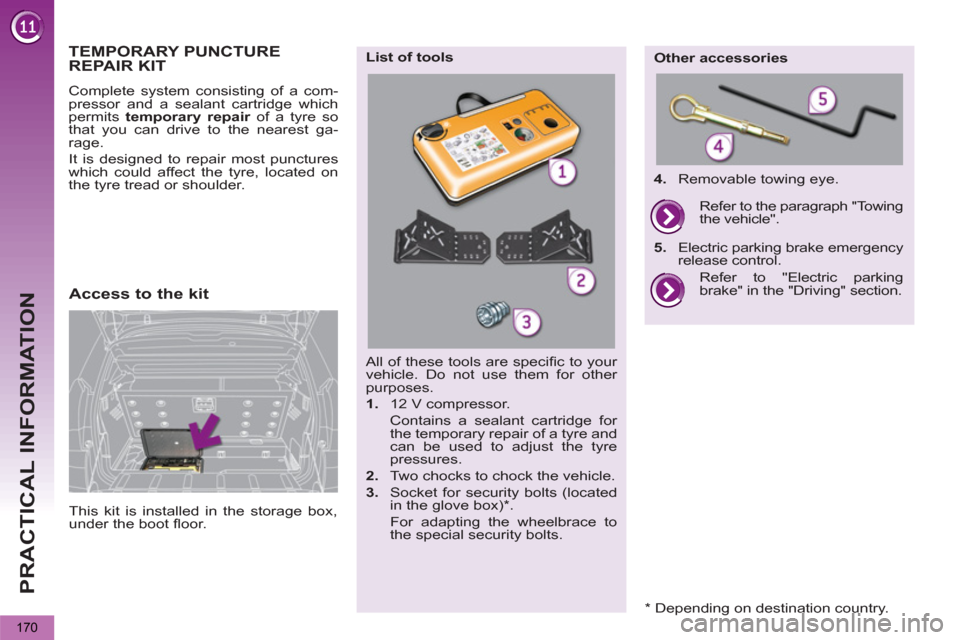
PRACTICAL INFORMATION
170
All of these tools are specifi c to your
vehicle. Do not use them for other
purposes.
1.
12 V compressor.
Contains a sealant cartridge for
the temporary repair of a tyre and
can be used to adjust the tyre
pressures.
2.
Two chocks to chock the vehicle.
3.
Socket for security bolts (located
in the glove box) * .
For adapting the wheelbrace to
the special security bolts.
List of tools
Other accessories
4.
Removable towing eye.
Refer to "Electric parking
brake" in the "Driving" section.
Refer to the paragraph "Towing
the vehicle".
5.
Electric parking brake emergency
release control.
TEMPORARY PUNCTUREREPAIR KIT
Complete system consisting of a com-
pressor and a sealant cartridge which
permits temporary repair
of a tyre so
that you can drive to the nearest ga-
rage.
It is designed to repair most punctures
which could affect the tyre, located on
the tyre tread or shoulder.
Access to the kit
This kit is installed in the storage box,
under the boot fl oor.
*
Depending on destination country.
Page 178 of 284
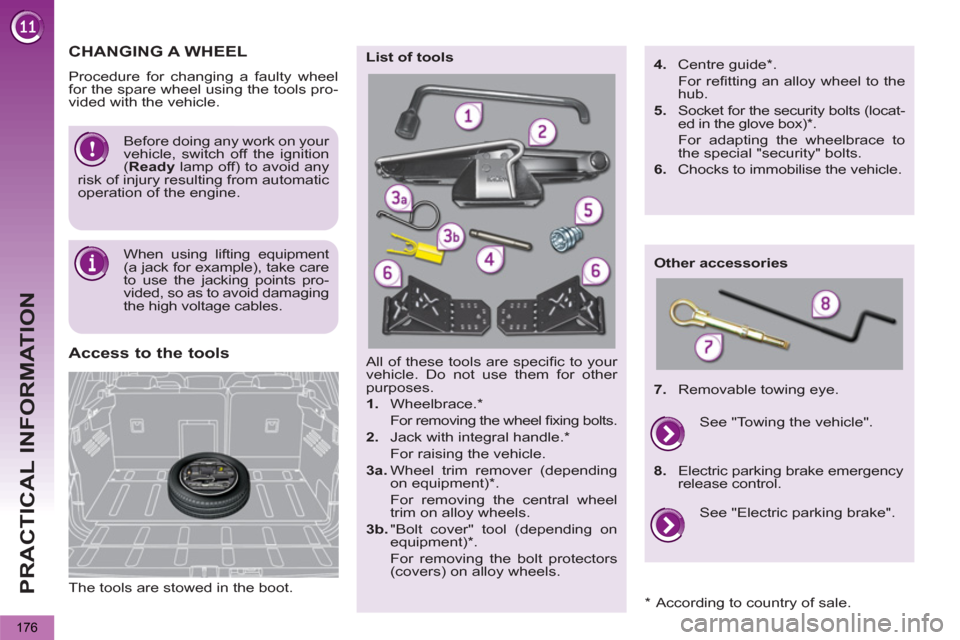
PRACTICAL INFORMATION
176
The tools are stowed in the boot.
Access to the tools
All of these tools are specifi c to your
vehicle. Do not use them for other
purposes.
1.
Wheelbrace. *
For removing the wheel fi xing bolts.
2.
Jack with integral handle. *
For raising the vehicle.
3a.
Wheel trim remover (depending
on equipment) * .
For removing the central wheel
trim on alloy wheels.
3b.
"Bolt cover" tool (depending on
equipment) * .
For removing the bolt protectors
(covers) on alloy wheels.
List of tools
Other accessories
4.
Centre guide * .
For refi tting an alloy wheel to the
hub.
5.
Socket for the security bolts (locat-
ed in the glove box) * .
For adapting the wheelbrace to
the special "security" bolts.
6.
Chocks to immobilise the vehicle.
7.
Removable towing eye.
See "Electric parking brake".
See "Towing the vehicle".
8.
Electric parking brake emergency
release control.
Before doing any work on your
vehicle, switch off the ignition
( Ready
lamp off) to avoid any
risk of injury resulting from automatic
operation of the engine.
When using lifting equipment
(a jack for example), take care
to use the jacking points pro-
vided, so as to avoid damaging
the high voltage cables.
CHANGING A WHEEL
Procedure for changing a faulty wheel
for the spare wheel using the tools pro-
vided with the vehicle.
*
According to country of sale.
Page 179 of 284
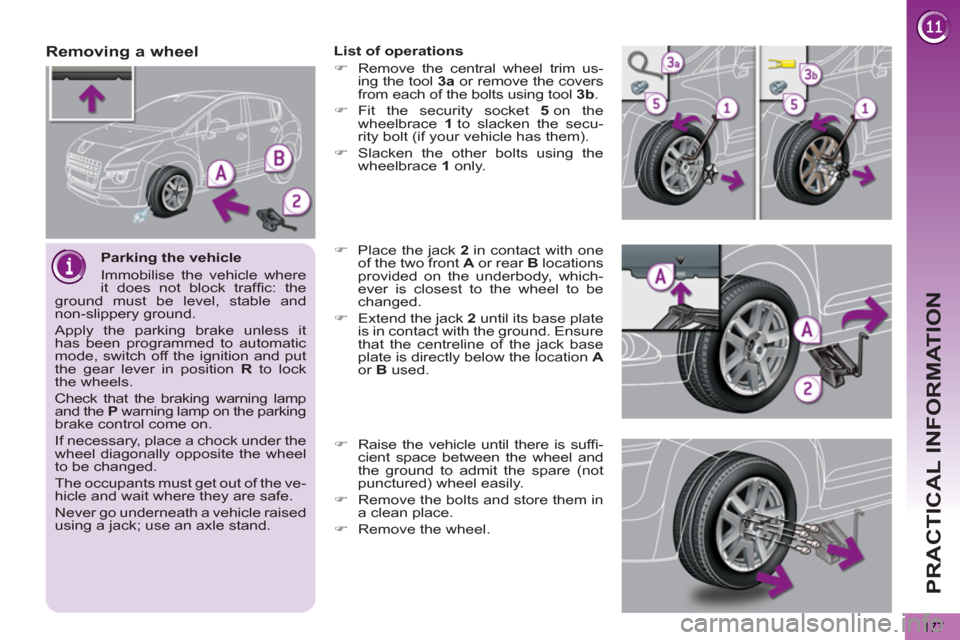
PRACTICAL INFORMATION
177
Parking the vehicle
Immobilise the vehicle where
it does not block traffi c: the
ground must be level, stable and
non-slippery ground.
Apply the parking brake unless it
has been programmed to automatic
mode, switch off the ignition and put
the gear lever in position R
to lock
the wheels.
Check that the braking warning lamp
and the P
warning lamp on the parking
brake control come on.
If necessary, place a chock under the
wheel diagonally opposite the wheel
to be changed.
The occupants must get out of the ve-
hicle and wait where they are safe.
Never go underneath a vehicle raised
using a jack; use an axle stand.
Removing a wheel
List of operations
�)
Remove the central wheel trim us-
ing the tool 3a
or remove the covers
from each of the bolts using tool 3b
.
�)
Fit the security socket 5
on the
wheelbrace 1
to slacken the secu-
rity bolt (if your vehicle has them).
�)
Slacken the other bolts using the
wheelbrace 1
only.
�)
Place the jack 2
in contact with one
of the two front A
or rear B
locations
provided on the underbody, which-
ever is closest to the wheel to be
changed.
�)
Extend the jack 2
until its base plate
is in contact with the ground. Ensure
that the centreline of the jack base
plate is directly below the location A
or B
used.
�)
Raise the vehicle until there is suffi -
cient space between the wheel and
the ground to admit the spare (not
punctured) wheel easily.
�)
Remove the bolts and store them in
a clean place.
�)
Remove the wheel.